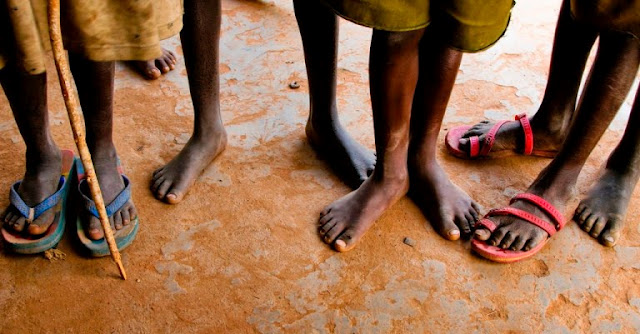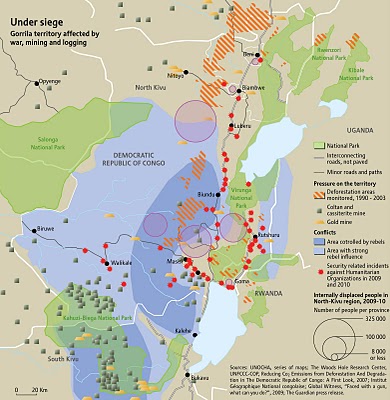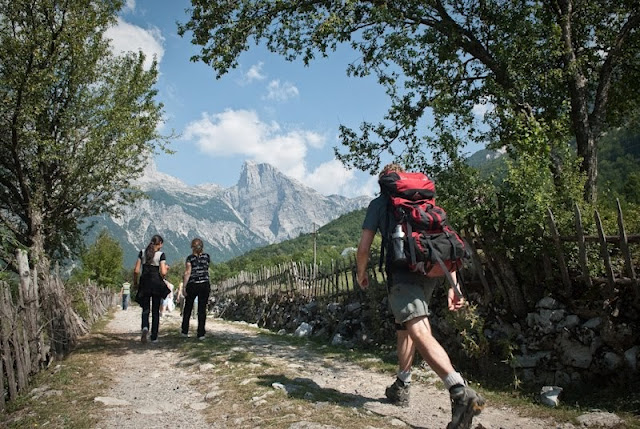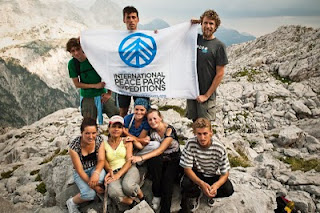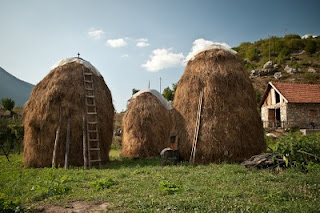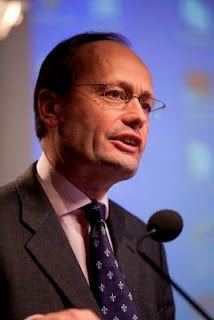-
Shape of Things to Come: Uganda’s Demographic Barriers to Democracy
›In March, Uganda’s cultural landmark, the Kasubi Tombs, were destroyed in a suspicious fire. Tensions spilled over when Ugandan President Yoweri Museveni paid a visit to the Bugandan site and found his entrance blocked by an angry crowd. According to an independent newspaper, soldiers accompanying the president opened fire, killing three civilians.
With ethnic-tinged unrest and student protests in Kampala, as well as cross-border conflicts in the north and east, Museveni, who has led Uganda since 1986, is facing a potentially serious test as elections approach early next year. The country’s demographic profile, and in particular the lack of opportunities for growing numbers of young people, will add to the country’s challenges, as I argue in a new case study of Uganda’s demography.
Uganda has the youngest population in the world, with 77 percent of its people younger than age 30. Women in Uganda have an average of 6.7 children each and 41 percent of married women have an unmet need for family planning. The population of Uganda is currently growing by about one million people per year, and given the force of its demographic momentum, Uganda’s population is likely to almost double by 2025 even if fertility declines.
Population Action International has found that countries with age structures like Uganda’s are the most likely to experience internal strife and autocratic governance. Between 1970 and 2007, 80 percent of outbreaks of civil conflict occurred in countries in which 60 percent or more of the population was younger than age 30.During that same period, 90 percent of countries with an age structure like Uganda’s had autocratic or only partially democratic governments.
Demography alone does not cause conflict. Most governments, even those with youthful populations, do not become entrenched in internal violence and upheaval. But age structure affects a country’s vulnerability to conflict, due to the demands a government faces in providing for its growing numbers.
In Uganda, young people face diminishing prospects in agriculture, the primary industry, as plot sizes shrink with each successive generation. At projected population growth rates, land density may increase 350 percent by 2050, from 122 inhabitants per km2 to a possible 551 inhabitants per km.
Only one-quarter of students who enroll in primary school reach the final grade, and even those with university degrees find few jobs. A reported youth unemployment rate of 22 percent is even higher in urban areas.
After 25 years in power, President Museveni will stand for a fourth official term in 2011. Despite growing dissent among his constituents, he appears confident of keeping his seat. Regardless of what happens next year,Uganda’s leaders must firmly commit to addressing their country’s demographic issues.
Age structure can become a window of opportunity if youth are engaged in society and couples can choose the number of children they can support. But in Uganda, that window remains far out of reach.
Three new case studies from Population Action International on Haiti, Yemen and Uganda examine the challenges specific to countries with very young age structures and recommend policy solutions.
Elizabeth Leahy Madsen is a senior research associate at Population Action International (PAI). She is the primary author of the 2007 PAI report The Shape of Things to Come: Why Age Structure Matters to a Safer, More Equitable World.
Photo Credits: “Atanga.pater.uganda,” courtesy of flickr user Kcarls. -
Shape of Things to Come: A Demographic Perspective of Haiti’s Reconstruction
›Last month, the International Donors’ Conference Towards a New Future for Haiti sought to lay the groundwork for Haiti’s long-term recovery by pledging an impressive $9.9 billion over the next decade. A large portion of the money will fund health, education, and employment efforts that are crucial to meeting the needs of Haiti’s people—particularly its youth. In a new case study of Haiti’s demography and development, Population Action International (PAI) argues that the country’s age structure should play a central role in any reconstruction strategy.
In Haiti, almost 70 percent of the population is under the age of 30, and this very youthful population affects every aspect of the country’s development prospects, from economic opportunities to security issues, political stability, gender equality, and climate change adaptation.
Haiti is at a demographic crossroads. If sound policies are in place, youthful age structures can translate into an economic asset for the country. The combination of decreasing fertility levels and a growing working-age population may open a window of opportunity for economic growth. To seize it, large-scale education and employment policies and programs should seek to raise employment rates for both male and female youth.
For Haiti to reap the benefits of this “demographic dividend,” access to reproductive health services is equally important. According to the most recent Demographic and Health Survey (2005-2006), if all unintended births were avoided, the average fertility level in the country would be 2.4 children instead of four.
But if instead, Haiti ignores the needs of its youth, the country will remain vulnerable to a variety of political and economic challenges. Youth unemployment is twice that of the rest of the population, which could have a negative impact on the country’s political stability and security situation.
The PAI report The Shape of Things to Come shows that countries with very young age structures are less likely than others to sustain democratic regimes and that age structure impacts political stability. To be an effective partner in its reconstruction, the Haitian government needs stable governance. By prioritizing education, health, and employment for young people, Haiti may reduce the risk of urban violence, help attract private investors, and speed its recovery.
Addressing demographic factors will also help Haiti achieve broader development goals. Decades of high population growth and the use of charcoal as the main source of energy have deforested 97 percent of the country, increasing Haiti’s inherent vulnerability to environmental disasters and climate change. Denuded landscapes contribute to devastating floods, especially in urban coastal zones. The lack of tree cover reduces the country’s ability to absorb carbon and causes wide variations in temperature. Due to soil erosion, Haiti’s agricultural industry is one of the least productive in the world, leading to widespread poverty and food insecurity.
The integration of demographic factors into development strategies constitutes one of the most compelling ways for Haiti to facilitate not only its reconstruction, but also address the challenges of climate change and make its population more resilient and prosperous.
Three new case studies from Population Action International on Haiti, Yemen and Uganda examine the challenges specific to countries with very young age structures and recommend policy solutions.
Béatrice Daumerie is a research fellow at Population Action International (PAI).
Photo: Haitian youth. Courtesy Flickr user NewsHour -
Demobilized Soldiers Developing Water Projects – and Peace
›Can demobilized ex-combatants help improve water resources in post-conflict countries? Last fall, the Global Water Institute (GWI) held a symposium in Brussels to find out.
Seventy representatives from the African Union, the United Nations, civil society, research institutes, and EU water policy advisors discussed ways in which former soldiers could be employed in the water sector to create peace dividends, bridge divided societies, and improve water security in countries recovering from conflict.
GWI, which is headquartered in Brussels and led by Valerie Ndaruzaniye, formerly of the Institute of Multi-Track Diplomacy’s Global Water Program, hopes to use the water sector development to meet multiple objectives in post-conflict reconstruction, such as:- increasing environmental security,
- reducing the likelihood of future conflict over water,
- enhancing security and stability, and
- employing demobilized ex-combatants to create peace dividends.
While disarmament, demobilization, and reintegration (DDR), is a fairly new process in post-conflict settings (the first program took place only 15 years ago), it has progressed rapidly in recent years, moving from a primarily military exercise to one focused on reintegration. Reintegration has also shifted from its exclusive focus on the ex-combatants, which often caused resentment in conflict-affected communities, to include women, children, youth, and the elderly and disabled, as well as the affected communities.
Reintegration is still the most difficult stage of any DDR program, not only for budgetary and political reasons, but also due to the processes of transitional justice and reconciliation. Through experience in the field, practitioners have realized that such programs are not simply technical exercises and must be better linked to wider recovery efforts and development programs for more sustainable results.
By supporting sustainable development in the water sector, and simultaneously contributing to reconciliation and peace dividends by involving ex-combatants in community development work, GWI can offer a substantial contribution to the reintegration process.
“Making the link between water management and DDR is a novel idea. GWI is a good example of integration of policy areas in order to build peace in some countries,” said Catherine Woolard, the director of the European Peacebuilding Liaison office.
Adrienne Stork is currently working on natural resource management and disarmament, demobilization, and reintegration programs jointly with the UNDP Bureau for Crisis Prevention and Recovery and the UNEP Disasters and Conflicts Unit in Geneva, Switzerland.
Photo Credits: Flickr User ISAFMEDIA, 080816-N-8726C-019 -
To Invest in a Sustainable Future, Fund Voluntary Family Planning
›President Obama’s proposed federal budget for FY2011 includes $715.7 million for international family planning and reproductive health assistance—10 percent ($67 million) more than what was included in the FY2010 budget that Congress approved last December. If approved, the FY2011 allocation would be 54 percent more than the FY2008 budget, which was equivalent to the amount allotted in 1974 when adjusted for inflation. The recent increases mark the end of more than 30 years of stagnation in U.S. funding for voluntary family planning—and herald a new investment in a sustainable future.
Over the last 20 years, the number of women of reproductive age in the developing world has increased by 465 million. Today, the Guttmacher Institute estimates that 201 million women in developing countries want but lack access to modern contraceptives. “Satisfying the unmet need for contraceptive services in developing countries would avert 52 million unintended pregnancies annually, which, in turn, would save more than 1.5 million lives and prevent 505,000 children from losing their mothers,” the Institute reports.
Rapid population growth in some of the world’s most economically disadvantaged countries poses a significant threat to their natural resources and the environment. Currently, more than 1 billion people live in ecological hotspots—areas that are both rich in plant and animal diversity and highly threatened by human activity. Although these areas comprise just 12 percent of the Earth’s land surface, they hold nearly 20 percent of the global population and possess a population growth rate nearly 40 percent greater than the world average. The cumulative impact of a growing global population, which demands more natural resources and exacerbates already unsustainable patterns of consumption, degrades the most basic foundations of life—air, water, croplands, forests, and fisheries—and contributes to climate change.
Improving access to voluntary family planning not only contributes to smaller, healthier families, but also eases the strain on natural resources. By giving couples the information and supplies to plan the number and timing of their children, U.S.-funded population and reproductive health programs have helped countries slow population growth and reduce population pressures on finite natural resources, including local habitats and wildlife. In addition, the success of USAID’s population, health, and environment programs also offers important lessons for climate change adaptation and building resilience in local communities.
In our interconnected environment, the impacts of natural resources use, management, and protection around the world are felt here in the United States. Despite the difficult budgetary and economic environment our country faces, the president’s request for approximately $716 million in international family planning and reproductive health assistance funding is a wise long-term investment. These resources are an important step toward the broader goal of investing $1 billion in these critical programs to create a healthier, more sustainable future for our world.
Rebecca Wadler Lase is the program associate for the Sustainability Education Program at the Izaak Walton League of America.
Map: “Poverty-Biodiversity Mapping Applications.” Courtesy UNEP/Grid Arendal. -
On the Air With Arab Demographics
›A recent radio interview on the “Demographics of the Arab World” should be a must listen for those in the World Bank, where discussions of the Arab youth bulge are largely off the table.
The interview with Magda Abu-Fadil of the American University of Beirut and Bernard Haykel of Princeton University suggests that scholars of the Arab world are not so timid, as also evidenced by UNDP’s 2009 Arab Human Development Report.
However, during the interview with Abu-Fadil and Haykel, Worldfocus’ Martin Savidge falls victim to two significant misconceptions that are worth mentioning for their pervasiveness among political science and economics communities:- Savidge believes that countries tend to risk political violence when their percentage of young adults is above 35 percent. This is close, but not quite correct. It’s the proportion of young adults in the adult population – i.e., the working-age population, as opposed to the population in general – that indicates a risk of fractious politics. Children (those below the age of 14) should not be counted in this indicator, yet in much of the literature they mistakenly are.
- Savidge believes that large numbers of youth are an economic “good deal.” Here, Abu-Fadil and Haykel set him straight, noting that a bulge among the young adult population produces a demographic bonus only when fertility has significantly declined; the childhood cohorts are small and the subject of increased investment; and the youth moving into adulthood are educated.
Big changes could occur along the edges of the Arab world in the coming decade. Fertility decline, more recently, has made its way to the Gulf Cooperation Council (GCC) states, although they still need a champion for women’s rights. Turkey had Ataturk, Iran had Reza Shah, and Tunisia had Habib Bourguiba. It’s no accident that these countries were the first to experience fertility decline and age structural changes—their leaders laid the groundwork decades ago.
Can a leader, however, with that amount of political guts and conviction emerge from the Saudi royal family? I’m doubtful.
Richard Cincotta is demographer-in-residence at the H.L. Stimson Center in Washington, DC.
Photo: Yemeni children courtesy Flickr user kebnekaise. -
Guerrillas vs. Gorillas in the Congo Basin
›Gorillas could disappear from the Congo basin in the next 10-15 years, according to a new report issued by the United Nations and Interpol. The Last Stand of the Gorilla – Environmental Crime and Conflict in the Congo Basin places responsibility for the decline of gorilla populations in the Democratic Republic of the Congo and its surrounding region squarely on the shoulders of resource-hungry militants, who poach gorilla bushmeat to feed hungry soldiers and mine workers and sell in local markets. Militants extract timber, charcoal, diamonds, and other resources to raise funds for arms, reducing gorilla territory.
Yet another rationale is retaliation against park rangers who attempt to limit their illegal activities within national parks. In the process, park rangers have found themselves, their parks, and their endangered charges targets of militant groups seeking to plunder and traffic goods through protected areas. “In Virunga Park alone, 190 park rangers have been killed in the last 15 years,” notes the report, which is also available in an interactive e-book edition.
Conflict with local communities also frequently leads to the slaughter of the gorillas and loss of their habitats. Displaced people and refugees also compete with gorillas for land. In several cases, gorillas facing shrinking natural domains have satisfied their appetites in banana plantations, and local farmers have struck back.
Strengthening Law Enforcement
Not all, however, is dire. The report finds several success stories stemming out of transboundary law enforcement collaboration and recommends increased training and support for local and international law enforcement groups. “The gorillas are yet another victim of the contempt shown by organized criminal gangs for national and international laws aimed at defending wildlife,” said David Higgins, Interpol’s Environmental Crime Programme Manager. “The law enforcement response must be internationally coordinated, strong, and united, and Interpol is uniquely placed to facilitate this.”
Law enforcement in the Congo Basin faces an uphill battle, in part due to conditions present in peace agreements between guerillas and the Congolese government. Removing vehicle checkpoints from important border crossings was key to the insurgents agreeing to peace. While these agreements reduced violence, they have created a highway for illegal exports. This trade props up the militant groups and undercuts the chances for peace on a regional scale. It is an example of how large remaining quantities of automatic weapons and turns to poaching by ex-militants can render post-conflict environments even more damaging to local wildlife than war itself.
Toward Coexistence
In some locations, conflicts between gorillas and local farmers are disappearing with the construction of natural barriers and as local populations realize the potential of ecotourism to generate greater revenue from thriving gorilla populations than collapsing ones. Greater international coordination and local commitment, however, are necessary. Turning threatening competition into beneficial cooperation is possible.
Tara Innes is a PhD student at the University of Maryland, studying conflict-environment linkages.
Photos: Gorilla, courtesy Flickr user mrflip; Gorilla Territory Affected by War, Mining, and Logging courtesy UNEP/GRID-Arendal. -
Imagine There Are No Countries: Conservation Beyond Borders in the Balkans
›International peace parks have captured the imagination of visionaries like Nelson Mandela, who called them a “concept that can be embraced by all.” Such parks—also known as transboundary protected areas—span national boundaries, testifying to the peaceful collaborative relationship between neighboring countries and to the co-existence of humans and nature.
Peace parks seek to simultaneously promote regional peace and stability, conserve biodiversity, and stimulate job creation. How can they accomplish such ambitious goals?- Biodiversity: The political borders and physical barriers within the park are removed, allowing animals and humans to migrate freely. In addition, surveys of the area’s biodiversity don’t stop at sovereign borders, but are instead conducted on an ecosystem basis.
- Job creation: Developing eco-tourism—one of the fastest-growing industries in the world—provides people living near peace parks an incentivized alternative to exhausting the very resource base on which their survival depends.
- Peace and stability: To jointly manage natural resources successfully requires countries to collaborate through cross-boundary committees on conservation, safety and security, finance, human resources, legislation, and tourism.
 My organization, International Peace Park Expeditions, uses experiential peacebuilding, academic programs, and professional trainings in international peace parks to integrate theory with practice. We seek to develop leadership and collaboration among three distinct, but complementary, groups: students and professors, transboundary protected area professionals, and youth from the peace park countries.
My organization, International Peace Park Expeditions, uses experiential peacebuilding, academic programs, and professional trainings in international peace parks to integrate theory with practice. We seek to develop leadership and collaboration among three distinct, but complementary, groups: students and professors, transboundary protected area professionals, and youth from the peace park countries.
Our Summer 2010 programs focus on the proposed peace park in the Western Balkans’ Prokletije/Bjeshket e Namuna mountains, between Albania and the newly independent countries of Montenegro (2006) and Kosovo (2008), which were formerly part of Yugoslavia. The Balkans Peace Park Project, a UK charity and their local network of partner organizations and individuals, first conceptualized the Balkans Peace Park, an area of approximately 4000 square km, in 2001.
This summer, participants in our professional training symposium will collaboratively develop a more precise and dynamic map. Students and young leaders in our other two programs will learn about peace parks while trekking together across the borders into all three countries.
Experiential Peacebuilding (July 19-25, 2010)
Experiential Peacebuilding programs combine outdoor experiential education and practical skills training in peacebuilding to foster the development of a community of young leaders capable of catalyzing positive peaceful changes in their communities. This summer’s program is being developed in conjunction with our local partner organizations (ERA and Marimangut in Kosovo; Outdoor Albania and High Albania in Albania; and PSD Prokletija in Montenegro). The primary goals of these programs are to unite youth from conflict-affected communities to develop relationships across borders; transform negative attitudes and stereotypes; and create a core group of young leaders with the skills, tools, and motivation to generate and direct changes in their communities.
Academic Expedition (June 7-26 and August 2-21, 2010)This three-week, three-credit course, “Conservation Beyond Borders,” will combine traditional academic teaching with proven experiential learning methodologies to create a unique, dynamic expedition that will provide students with a strong understanding of the theory and practice of international peace parks. Course readings and lectures will provide the academic base, and guest lectures from subject-matter experts working in the field will create the bridge; both will address sustainable forestry management, biodiversity surveys, eco-tourism plans, development and infrastructure planning, environmental conservation, water resource management, peacebuilding initiatives, and cross-border projects. First-hand experience trekking through the proposed Balkans Peace Park, crossing the borders of Albania, Kosovo, and Montenegro, and living among the local people will bring theory to life.
Professional Training Symposium (July 8-9, 2010)
This year’s Professional Field Training Symposium, “Critical Transboundary Environmental Linkages,” will bring together experts, policymakers, and stakeholders from the Prokletije/Bjeshket e Namuna region to discuss cross-border ecotourism, biodiversity mapping, and sustainable forestry management. The symposium seeks to build trust through cross-border collaboration, and to improve environmental management in the peace park region. Participants will create a Google Earth map to house shared environmental data and visit two project sites in the proposed peace park. Todd Walters is the founder and executive director of International Peace Park Expeditions. He holds a master’s degree in International Peace and Conflict Resolution from American University’s School of International Service, and is a National Outdoor Leadership School (NOLS) certified wilderness guide. While at AU, he worked as an intern for the Environmental Change and Security Program.
Todd Walters is the founder and executive director of International Peace Park Expeditions. He holds a master’s degree in International Peace and Conflict Resolution from American University’s School of International Service, and is a National Outdoor Leadership School (NOLS) certified wilderness guide. While at AU, he worked as an intern for the Environmental Change and Security Program.
Photos courtesy IPPE/Cory Wilson. -
Climate Change: A Threat to Global Security
› Having recently returned from Washington, where I shared a platform at the Woodrow Wilson Center with Deputy Assistant Secretary of Defense Amanda Dory, I am struck by how similar UK and U.S. thinking is on the national security implications of climate change. Our defense departments agree that the impact of climate change is likely to be most severe in areas where it coincides with other stresses, such as poverty, demographic growth, and resource shortages: areas through which much of the world’s trade already passes. We are also in agreement that climate change will accelerate global instability and that it is likely to shape our future missions and tasks. In particular we can expect to receive more frequent requests for assistance after extreme weather events.
Having recently returned from Washington, where I shared a platform at the Woodrow Wilson Center with Deputy Assistant Secretary of Defense Amanda Dory, I am struck by how similar UK and U.S. thinking is on the national security implications of climate change. Our defense departments agree that the impact of climate change is likely to be most severe in areas where it coincides with other stresses, such as poverty, demographic growth, and resource shortages: areas through which much of the world’s trade already passes. We are also in agreement that climate change will accelerate global instability and that it is likely to shape our future missions and tasks. In particular we can expect to receive more frequent requests for assistance after extreme weather events.
So if we recognize the threats, what can we do about them? In the United Kingdom we believe that the approach is two-fold. First, we need to address the problem that we have already caused, the damage that we have done to the climate out to about 2030, through adaptation and planning for potential scenarios. But to limit the threat to our security, we must also address the underlying causes.
Key to achieving this is limiting temperature rises to 3.6 degrees Fahrenheit, when compared with pre-industrial times, since beyond that, the risks will increase greatly. This will be no easy task and will require us to start cutting our emissions now, taking action by being more efficient and investing in low-carbon technology. The United Kingdom has the world’s first legally binding emissions reduction targets, and is investing in a variety of technologies, including wind, nuclear, and carbon capture and storage. These measures will not only contribute to our long-term security by reducing damaging carbon emissions, but they will also insulate us against fossil fuel price fluctuations and thereby increase our energy security.
It is the job of any responsible military to plan not just for the national security challenges that face us currently, but for those that might appear on our horizon in the future. Sometimes new challenges appear from newly destabilized areas of the world. Sometimes they arise from new methods of warfare, or new trends in science and technology. Often, they stem from changes in the conditions under which our militaries operate. Just as we are alive to geopolitical trends in every continent, and technical advances made by both our allies and those who seek to harm our interests, our militaries must proactively anticipate the environmental changes that will impact our national security in the coming years. Current military operations will, rightly, always be our highest priority, but we must also find time to address future threats, including climate change.
Indeed, in some countries climate change is already impacting on the work of the military. When I talk to colleagues from Africa and Southeast Asia it is apparent that they are already taking into account the consequences of climate change when determining their priorities.
The United States and United Kingdom can work together to establish a greater understanding of the security implications of climate change and how they will affect our missions and tasks. We cannot afford to be caught unprepared when climate-related conflicts challenge our ability to deliver our core mission of providing national security – a risk that we must avoid.
Rear Admiral Neil Morisetti is an active duty officer in the British Royal Navy and is the United Kingdom’s Climate Security Envoy
Showing posts from category Guest Contributor.


